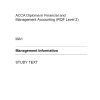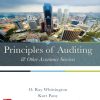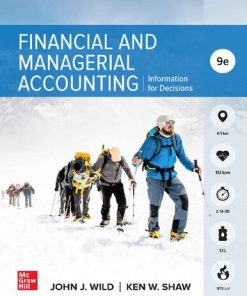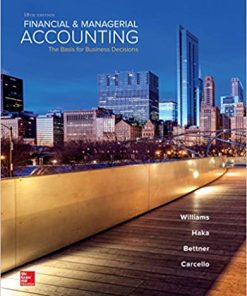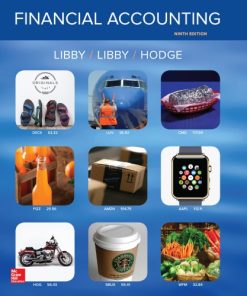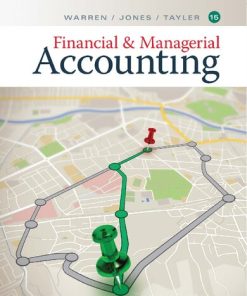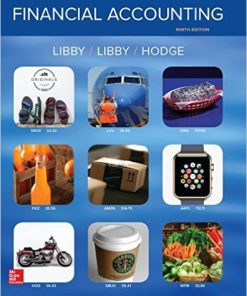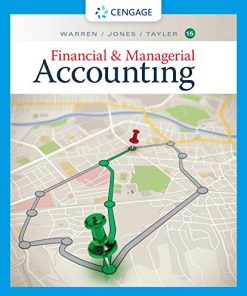(Ebook PDF) Financial and Managerial Accounting 9th Edition by John Wild 1264098588 9781264098583 full chapters
$50.00 Original price was: $50.00.$25.00Current price is: $25.00.
Financial and Managerial Accounting 9th Edition by John J. Wild – Ebook PDF Instant Download/DeliveryISBN: 1264098588, 9781264098583
Full download Financial and Managerial Accounting 9th Edition after payment.
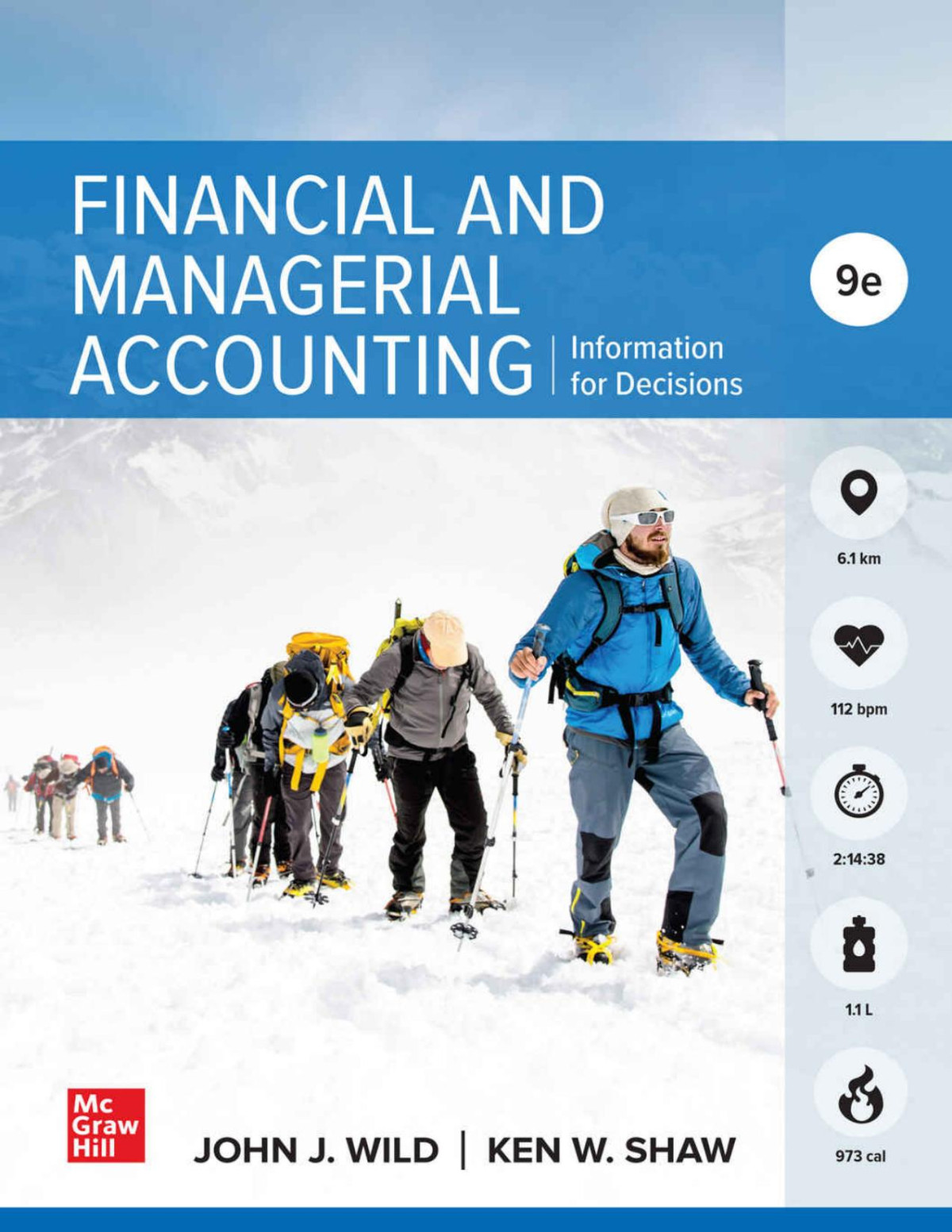
Product details:
ISBN-10 : 1264098588
ISBN-13 : 9781264098583
Author: John J. Wild
The Wild Financial and Managerial Accounting text has quickly become the market leading text that provide a corporate perspective with balanced coverage in this growing course area. With its step-by-step approach and the author?s accessible writing style, Financial and Managerial Accounting streamlines complex accounting processes and helps students build confidence by mastering key concepts and procedures. With content that is presented in organized learning blocks ending with a need-to-know examples, the text makes it easy for students to find the most relevant content needed to solve problems. Chapter opening vignettes use dynamic, well-known entrepreneurs to appeal to all students and show the relevance of accounting. Students are encouraged to think like a businessperson and apply what they learn. A wide variety of assignments provide instructors with flexibility to teach, assess, and challenge students on several levels. Join your colleagues and the millions of students that have used this best-selling learning system to advance their education and careers.
Financial and Managerial Accounting 9th Table of contents:
1 Accounting in Business
Importance of Accounting
Users of Accounting Information
Opportunities in Accounting
Fundamentals of Accounting
Ethics—A Key Concept
Generally Accepted Accounting Principles
Conceptual Framework
Business Transactions and Accounting
Accounting Equation
Transaction Analysis
Summary of Transactions
Financial Statements
Income Statement
Statement of Retained Earnings
Balance Sheet
Statement of Cash Flows
Decision Analysis—Return on Assets
2 Accounting for Business Transactions
Basis of Financial Statements
Source Documents
“Account” Underlying Financial Statements
Ledger and Chart of Accounts
Double-Entry Accounting
Debits and Credits
Double-Entry System
Analyzing and Processing Transactions
Journalizing and Posting Transactions
Processing Transactions—An Example
Summarizing Transactions in a Ledger
Trial Balance and Financial Statements
Preparing a Trial Balance
Financial Statements Prepared from Trial Balance
Decision Analysis—Debt Ratio
3 Adjusting Accounts for Financial Statements
Timing and Reporting
The Accounting Period
Accrual Basis versus Cash Basis
Recognizing Revenues and Expenses
Framework for Adjustments
Deferral of Expense
Prepaid Insurance
Supplies
Other Prepaid Expenses
Depreciation
Deferral of Revenue
Unearned Consulting Revenue
Accrued Expense
Accrued Salaries Expense
Accrued Interest Expense
Future Cash Payment of Accrued Expenses
Accrued Revenue
Accrued Services Revenue
Accrued Interest Revenue
Future Cash Receipt of Accrued Revenues
Links to Financial Statements
Trial Balance and Financial Statements
Adjusted Trial Balance
Preparing Financial Statements
Closing Process
Temporary and Permanent Accounts
Recording Closing Entries
Post-Closing Trial Balance
Accounting Cycle
Classified Balance Sheet
Classification Structure
Classification Categories
Decision Analysis—Profit Margin and Current Ratio
Appendix 3A Alternative Accounting for Prepayments
Appendix 3B Work Sheet as a Tool
Appendix 3C Reversing Entries
4 Accounting for Merchandising Operations
Merchandising Activities
Reporting Income for a Merchandiser
Reporting Inventory for a Merchandiser
Operating Cycle for a Merchandiser
Inventory Systems
Merchandise Purchases
Purchases without Cash Discounts
Purchases with Cash Discounts
Purchases with Returns and Allowances
Purchases and Transportation Costs
Merchandise Sales
Sales without Cash Discounts
Sales with Cash Discounts
Sales with Returns and Allowances
Adjusting and Closing for Merchandisers
Adjusting Entries for Merchandisers
Closing Entries for Merchandisers
Summary of Merchandising Entries
More on Financial Statement Formats
Multiple-Step Income Statement
Single-Step Income Statement
Classified Balance Sheet
Decision Analysis—Acid-Test and Gross Margin Ratios
Appendix 4A Periodic Inventory System
Appendix 4B Adjusting Entries under New Revenue Recognition Rules
Appendix 4C Net Method for Merchandising
5 Inventories and Cost of Sales
Inventory Basics
Determining Inventory Items
Determining Inventory Costs
Internal Controls and Taking a Physical Count
Inventory Costing under a Perpetual System
Inventory Cost Flow Methods
Inventory Costing Illustration
Specific Identification
First-In, First-Out
Last-In, First-Out
Weighted Average
Financial Statement Effects of Costing Methods
Tax Effects of Costing Methods
Valuing Inventory at LCM and analyzing Inventory Errors
Lower of Cost or Market
Financial Statement Effects of Inventory Errors
Decision Analysis—Inventory Turnover and Days’ Sales in Inventory
Appendix 5A Inventory Costing under a Periodic System
Appendix 5B Inventory Estimation Methods
6 Cash, Fraud, and Internal Control
Fraud and Internal Control
Purpose of Internal Control
Principles of Internal Control
Technology, Fraud, and Internal Control
Blockchain as a Control
Limitations of Internal Control
Control of Cash
Cash, Cash Equivalents, and Liquidity
Cash Management
Control of Cash Receipts
Control of Cash Payments
Banking Activities as Controls
Basic Bank Services
Bank Statement
Bank Reconciliation
Decision Analysis—Days’ Sales Uncollected
Appendix 6A Documentation and Verification
7 Accounting for Receivables
Valuing Accounts Receivable
Direct Write-Off Method
Allowance Method
Estimating Bad Debts for Allowance Method
Percent of Sales Method
Percent of Receivables Method
Aging of Receivables Method
Notes Receivable
Computing Maturity and Interest
Recording Notes Receivable
Valuing and Settling Notes
Disposal of Receivables
Decision Analysis—Accounts Receivable Turnover
8 Accounting for Long-Term Assets
Cost Determination
Machinery and Equipment
Buildings
Land Improvements
Land
Lump-Sum Purchase
Depreciation
Factors in Computing Depreciation
Depreciation Methods
Partial-Year Depreciation
Change in Estimates
Additional Expenditures
Ordinary Repairs
Betterments and Extraordinary Repairs
Disposals of Plant Assets
Discarding Plant Assets
Selling Plant Assets
Cost Determination and Depletion
Plant Assets Tied into Extracting
Cost Determination and Amortization
Types of Intangibles
Decision Analysis—Total Asset Turnover
Appendix 8A Exchanging Plant Assets
9 Accounting for Current Liabilities
Known Liabilities
Characteristics of Liabilities
Examples of Known Liabilities
Accounts Payable
Sales Taxes Payable
Unearned Revenues
Short-Term Notes Payable
Payroll Liabilities
Employee Payroll and Deductions
Employer Payroll Taxes
Employee and Employer Payroll Taxes Summary
Internal Control of Payroll
Multi-Period Known Liabilities
Estimated Liabilities
Health and Pension Benefits
Vacation Benefits
Bonus Plans
Warranty Liabilities
Multi-Period Estimated Liabilities
Contingent Liabilities
Accounting for Contingent Liabilities
Applying Rules of Contingent Liabilities
Uncertainties That Are Not Contingencies
Decision Analysis—Times Interest Earned Ratio
Appendix 9A Payroll Reports, Records, and Procedures
Appendix 9B Corporate Income Taxes
10 Accounting for Long-Term Liabilities
Basics of Bonds
Bond Financing
Bond Issuing
Bond Trading
Par Bonds
Discount Bonds
Bond Discount or Premium
Issuing Bonds at a Discount
Premium Bonds
Issuing Bonds at a Premium
Bond Retirement
Long-Term Notes Payable
Installment Notes
Mortgages
Decision Analysis—Debt Features and the Debt-to-Equity Ratio
Appendix 10A Bond Pricing 401
Appendix 10B Effective Interest Amortization
Appendix 10C Leases and Pensions
11 Corporate Reporting and Analysis
Corporate Form of Organization
Corporate Advantages
Corporate Disadvantages
Corporate Organization and Management
Corporate Stockholders
Corporate Stock
Common Stock
Issuing Par Value Stock
Issuing No-Par Value Stock
Issuing Stated Value Stock
Issuing Stock for Noncash Assets
Dividends
Cash Dividends
Stock Dividends
Stock Splits
Financial Statement Effects of Dividends and Splits
Preferred Stock
Issuance of Preferred Stock
Dividend Preference of Preferred Stock
Reasons for Issuing Preferred Stock
Treasury Stock
Purchasing Treasury Stock
Reissuing Treasury Stock
Reporting of Equity
Statement of Retained Earnings
Statement of Stockholders’ Equity
Decision Analysis—Earnings per Share, Price-Earnings Ratio, and Dividend Yield
12 Reporting Cash Flows
Basics of Cash Flow Reporting
Purpose of the Statement of Cash Flows
Importance of Cash Flows
Measurement of Cash Flows
Classification of Cash Flows
Noncash Investing and Financing
Format of the Statement of Cash Flows
Preparing the Statement of Cash Flows
Cash Flows from Operating
Indirect and Direct Methods of Reporting
Applying the Indirect Method
Summary of Adjustments for Indirect Method
Cash Flows from Investing
Three-Step Analysis
Analyzing Noncurrent Assets
Cash Flows from Financing
Three-Step Analysis
Analyzing Noncurrent Liabilities
Analyzing Equity
Proving Cash Balances
Summary Using T-Accounts
Decision Analysis—Cash Flow Analysis
Appendix 12A Spreadsheet Preparation of the Statement of Cash Flows
Appendix 12B Direct Method of Reporting Operating Cash Flows
13 Analysis of Financial Statements
Basics of Analysis
Purpose of Analysis
Building Blocks of Analysis
Information for Analysis
Standards for Comparisons
Tools of Analysis
Horizontal Analysis
Comparative Statements
Trend Analysis
Vertical Analysis
Common-Size Statements
Data Visualizations
Ratio Analysis
Liquidity and Efficiency
Solvency
Profitability
Market Prospects
Summary of Ratios
Decision Analysis—Analysis Reporting
Appendix 13A Sustainable Income
14 Managerial Accounting Concepts and Principles
Managerial Accounting Basics
Purpose of Managerial Accounting
Nature of Managerial Accounting
Fraud and Ethics in Managerial Accounting
Career Paths
Cost Concepts
Direct versus Indirect
Manufacturing Costs
Prime and Conversion Costs
Product versus Period Costs
Cost Concepts for Service Companies
Reporting
Reporting Inventory on the Balance Sheet
Reporting Cost of Goods Sold on the Income Statement
Cost Flows and Cost of Goods Manufactured
Flow of Manufacturing Activities
Schedule of Cost of Goods Manufactured
Trends in Managerial Accounting
Decision Analysis—Raw Materials Inventory Turnover and Days’ Sales in Raw Materials Inventory
15 Job Order Costing
Job Order Costing
Job Order Production
Job Order vs. Process Operations
Production Activities in Job Order Costing
Cost Flows
Job Cost Sheet
Materials and labor Costs
Materials Cost Flows and Documents
Labor Cost Flows and Documents
Overhead Costs
Set Predetermined Overhead Rate
Apply Estimated Overhead to Jobs
Record Actual Overhead
Cost Flows to Financial Statements
Using Job Cost Sheets for Managerial Decisions
Schedule of Cost of Goods Manufactured
Financial Statements
Closing Overhead
Factory Overhead Account
Close Underapplied or Overapplied Overhead
Job Order Costing of Services
Decision Analysis—Pricing for Services
16 Process Costing and Analysis
Process Operations
Organization of Process Operations
Comparing Process and Job Order Costing Systems
Process Costing Demonstration
Step 1: Determine Physical Flow of Units
Step 2: Compute Equivalent Units of Production
Step 3: Compute Cost per Equivalent Unit
Step 4: Assign and Reconcile Costs
Production Cost Report
Accounting for Process Costing
Accounting for Production Costs
Accounting for Transfers
Trends in Process Operations
Decision Analysis—Hybrid Costing System
Appendix 16A FIFO Method of Process Costing
17 Activity-Based Costing and Analysis
Overhead Cost Allocation Methods
Plantwide Overhead Rate Method
Applying Plantwide Overhead Rate Method
Departmental Overhead Rate Method
Activity-Based Costing
Applying Activity-Based Costing
Activity Levels and Cost Management
Assessing Activity-Based Costing
ABC for Service Providers
Activities for Service Providers
Applying Activity-Based Costing to a Service Provider
Decision Analysis—Customer Profitability
18 Cost Behavior and Cost-Volume-Profit Analysis
Identifying Cost Behavior
Fixed Costs
Variable Costs
Graphing Fixed and Variable Costs
Mixed Costs
Step-wise Costs
Measuring Cost Behavior
Scatter Diagram
High-Low Method
Regression
Comparing Cost Estimation Methods
Contribution Margin and Break-Even Analysis
Contribution Margin
Break-Even Point
Changes in Estimates
Applying Cost-Volume-Profit Analysis
Margin of Safety
Computing Income from Expected Sales and Costs
Computing Sales for a Target Income
Evaluating Business Strategies
Sales Mix and Break-Even
Assumptions in Cost-Volume-Profit Analysis
Decision Analysis—Degree of Operating Leverage
Appendix 18A Using Excel for Cost Estimation
Appendix 18B Variable Costing and Performance Reporting
19 Variable Costing and Analysis
Introducing Variable Costing and Absorption Costing
Computing Unit Product Cost
Income Reporting
Units Produced Equal Units Sold
Units Produced Exceed Units Sold
Units Produced Are Less Than Units Sold
Summarizing Income Reporting
Production and Pricing
Planning Production
Setting Target Price
Analyzing Special Orders
Variable Costing for Services
Decision Analysis—Contribution Margin Ratio
Appendix 19A Converting Income from Variable Costing to Absorption Costing
20 Master Budgets and Planning
Budget Process and Administration
Budgeting Process
Benefits of Budgeting
Budgeting and Human Behavior
Budget Reporting and Timing
Operating Budgets
Master Budget Components
Sales Budget
Production Budget
Direct Materials Budget
Direct Labor Budget
Factory Overhead Budget
Budgeted Cost of Goods Sold
Selling Expense Budget
General and Administrative Expense Budget
Investing and Financing Budgets
Capital Expenditures Budget (Investing Budget)
Cash Budget (Financing Budget)
Budgeted Financial Statements
Budgeted Income Statement
Budgeted Balance Sheet
Decision Analysis—Direct Labor Budget and Revenue per Employee
Appendix 20A Merchandise Purchases Budget
21 Flexible Budgets and Standard Costs
Fixed and Flexible Budgets
Fixed Budget Performance Report
Flexible Budget Reports
Standard Costing
Standard Costs
Setting Standard Costs
Cost Variance Analysis
Direct Materials and Direct Labor Variances
Direct Materials Variances
Direct Labor Variances
Overhead Standards and Variances
Flexible Overhead Budgets
Standard Overhead Rate
Computing Overhead Variances
Overhead Variance Report
Decision Analysis—Sales Variances
Appendix 21A Expanded Overhead Variances and Standard Cost Accounting System
22 Performance Measurement and Responsibility Accounting
Responsibility Accounting
Performance Evaluation
Controllable versus Uncontrollable Costs
Responsibility Accounting for Cost Centers
Profit Centers
Expenses
Expense Allocations
Departmental Income Statements
Departmental Contribution to Overhead
Investment Centers
Return on Investment and Residual Income
Profit Margin and Investment Turnover
Balanced Scorecard and Transfer Pricing
Balanced Scorecard
Transfer Pricing
Decision Analysis—Cash Conversion Cycle
Appendix 22A Joint Costs and Their Allocation
23 Relevant Costs for Managerial Decisions
Decisions and Information
Decision Making
Relevant Costs and Benefits
Production Decisions
Make or Buy
Sell or Process
Scrap or Rework
Sales Mix When Resources Constrained
Capacity Decisions
Segment Elimination
Keep or Replace
Pricing Decisions
Normal Pricing 910
Special Pricing
Decision Analysis—Time and Materials Pricing
24 Capital Budgeting and Investment Analysis
Payback Period
Payback Period with Equal Cash Flows
Payback Period with Unequal Cash Flows
Accounting Rate of Return
Net Present Value (NPV)
Internal Rate of Return (IRR)
Comparing Capital Budgeting Methods
Decision Analysis—Break-Even Time (BET)
People also search for Financial and Managerial Accounting 9th:
difference between financial and managerial accounting
principles of financial and managerial accounting d196
financial and managerial accounting 9th edition
horngren’s financial and managerial accounting
financial and managerial accounting 9th edition access code
Tags:
Financial,Managerial Accounting,John Wild,Managerial
You may also like…
Business & Economics - Accounting
Business & Economics - Management & Leadership
Uncategorized
Business & Economics - Accounting
Uncategorized


